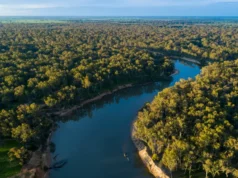
Know My Name: Australian Women Artists 1900 To Now (National Gallery of Australia)
When the idea of a portrait wall consisting entirely of female Australian artists was pitched at the NGA, a question was raised: how many people will know their names? Bringing names to prominence is not so much the aim as a happy by-product of an exhibition that shines a light on artists and works often relegated to the periphery. Indigenous artists are well represented, with a new commission from the Tjanpi Desert Weavers telling the story of the Seven Sisters star cluster through woven grass figures.
Family, the environment, social uprising and the struggle for women to carve a space for themselves in both society and the world of art are thoughtfully explored in works by Sally Gabori, Kathy Temin, Mikala Dwyer, Julie Rrap, Ethel Carrick and Micky Allen. Curators say when we get to the point where exhibitions like Know My Name are no longer needed, then it will have fulfilled its mission.
knowmyname.nga.gov.au/
Endeavour Voyage (National Museum of Australia)
Three striking installations of waterspouts set the scene for a colourful exhibition that offers contrasting perspectives and contemporary interpretations on Captain James Cook’s 1770 voyage up Australia’s east coast. When Endeavour first approached Australia, the crew was greeted by huge waterspouts. To the British sailors it was wondrous, but to the Yuin Monaro people it was a bad omen.
The increasingly volatile topic of British colonisation is handled with sensitivity and tact (and even humour, such as in a clip from the 1986 satirical film Babakuieria, where the colonial tables are turned). A dialogue is established through crew diary quotes and newly commissioned works from Indigenous communities where Cook landed (or floundered, in the case of Endeavour River in Far North Queensland). Cook’s interactions with the community bore both conflict and reconciliation, two common themes in an exhibition that helps us learn from the past so we might move forward together.
nma.gov.au/exhibitions/endeavour-voyage.
Pub Rock (National Portrait Gallery)
Jimmy Barnes stands drenched in sweat at the Coogee Bay Hotel, arms raised like a champion boxer, one hand holding a towel, the other a bottle of vodka. A flailing Peter Garrett tears up the stage like a tornado. Bon Scott wraps his arms around two stunned fans post-gig. A brooding Michael Hutchence laps up the adoration.
Pub rock’s heyday may have been the 70s and 80s, but this photographic exhibition goes back to the 50s when The Easybeats met at the Villawood Migrant Hostel, and it follows the theme of migration, connection and cross-pollination up to the present day.
Pubs are cast as incubators for bands that would go on to achieve overseas fame, and long-gone Canberra venues are celebrated as midweek stopovers on the touring circuit. A graffiti wall injects some edginess, and homage is paid to protest movements where rock ’n’ roll served as a vehicle for social and political change.
portrait.gov.au/exhibitions/pub-rock-2020
Various exhibitions (Canberra Museum and Gallery)
Canberra Museum and Gallery uncovers the social history of a city whose cultural achievements are often as overlooked as the gallery that celebrates them. Seeing Canberra travels back to when the city was a swath of grassland threaded by a meandering river, and celebrates artists such as Richard Larter and Michael Taylor who embraced and documented the landscape. Crafting Canberra examines how the city literally crafted a community and forged an identity. Signs Of The Times exhumes popular haunts that gave Canberra its cultural heart, such as Impact Records, The Australian Girls Own Gallery and Electric Shadows cinema.
The Nolan Collection showcases Sidney Nolan paintings from 1945 to 1953, while The Blade is lawn porn for all us cultivators of our own patch of suburban bliss. An engaging and often surprising immersion in life in the nation’s capital.
cmag.com.au/




